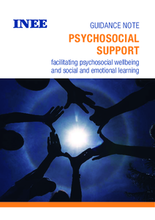This INEE Guidance Note addresses a gap in the tools that are currently available to educators and professionals operating in emergency and crisis contexts. Although many resources specific to psychosocial programming exist, including the foundational guidance for the humanitarian sector referenced in this document, INEE members working in contexts as diverse as the Ebola crisis in West Africa, the aftermath of the Nepalese earthquake, and the ongoing Syrian crisis expressed a need for PSS guidance that was specifically oriented to the education sector. This INEE Guidance Note encourages more intentional and consistent implementation of practical, good-quality psychosocial interventions on the education frontlines by teachers, education administrators, parents, counselors, peers, ministries, and other education personnel in three concrete ways:
• The Guidance Note clarifies the education sector’s importance in supporting the psychosocial wellbeing of children and youth.
• The Guidance Note provides educators with practical tips and advice about how to integrate PSS into formal and non-formal education efforts.
• The Guidance Note highlights linkages between PSS in education and other sectors.
Keeping schools open or providing alternative learning spaces during and after a crisis can provide a safe environment for children and youth and their families, but doing so can be extremely challenging. Embedding practical PSS and SEL activities (including peer-to-peer support, cooperative play, emotionregulation exercises, role-play, reflective discussions, etc.) into student-student and student-teacher relationships can improve the relevance and quality of this education, and it often yields positive results for learners, teachers, and communities (NRC, 2017; UNICEF, 2009). Conversely, the psychological impact of an acute and protracted crisis can limit children’s and youths’ ability to learn; therefore, failing to incorporate PSS and SEL into formal and nonformal education spaces risks stunting their academic growth. Not creating a supportive learning environment thus carries significant risk and can seriously limit young people’s learning and life opportunities.

